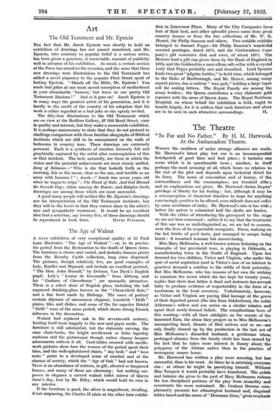The Age of Walnut A LOAN exhibition of very exceptional
quality at 25 Park Lane illustrates " The Age of Walnut "—or, to be precise, the period from the Restoration to the death of Queen Anne. The furniture is choice and varied, and includes famous pieces from the Hornby Castle collection, long since dispersed. The pictures, though relatively few, are good examples of Lely, timelier and Mignard, and include an excellent portrait, " The Hon. John Russell," by Dobson, Van Dyck's English pupil. Lely's " Louise de Kerouaille " from Althorp, and his " Graham of Claverhouse " are unusually attractive. There is a select show of English glass, including the tall engraved drinking-glass known as the " Chesterfield flute," and a fine bowl made by Bishopp. The cases of pottery contain slipware of uncommon elegance, Lambeth " Delft " plates, tiles and dishes, and some of the far superior Bristol "Delft" ware of the same period, which shows strong French influence in the decoration.
Walnut had replaced oak in the seventeenth century, lending itself more happily to the new and gayer mode. The furniture is still substantial, but the elaborate carving, the cane chair-backs, the bright needlework or Soho tapestry cushions and the picturesque though rather clumsy lacquer adornments enliven it all. Card-tables covered with needle- work pictures show how the women of the period spent their time, and the well-upholstered chairs, " day beds " and " love seats" point to a developed sense of comfort and of the charms of society, which the " Age of Oak " had not known. There is an abundance of mirrors, in gilt, silvered or lacquered frames, and many of them are charming ; but nothing sur- passes in elegance a carved walnut toilet mirror of Queen Anne's day, lent by Mr. Riley, which would hold its own in any interior.
If the furniture is good, the silver is magnificent, rivalling, if not surpassing, the Charles II plate at the other loan exhibi-
tion in Grosvenor Place. Many of the City Companies have lent of their best, and _other splendid pieces come from great country houses or from the fine collections of Mr. W. R. Hearst, Sir Philip Sassoon and others. Two notable exhibits belonged to Samuel Pepys—Sir Philip Sassoon's wonderful covered porringer, dated 1671, and the Clothworkers Com• pany's gilt rosewater dish and ewer, of about 1677. The Mercers lend a gilt cup given them by the Bank of England.in 1694, and the Goldsmiths a marvellous salt-cellar with a crystal body that Pepys probably saw and described. Lord Spencer lends two great "pilgrim bottles," to hold wine, which belonged to the Duke of Marlborough, and Mr. Hearst, among many superb pieces, has a curious " wax jack," holding a large taper roll for sealing letters. The Royal Family are among the many lenders ; the Queen contributes a very elaborate gold repeater with the arms of Queen Anne. The Royal Northern Hospital, on whose behalf the exhibition is held, ought to benefit largely, for it is seldom that such furniture and silver
are to be seen in such attractive surroundings. H.


































 Previous page
Previous page